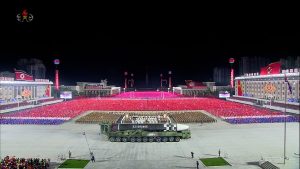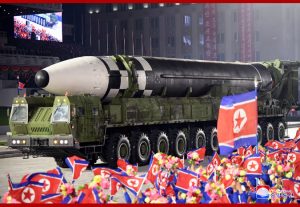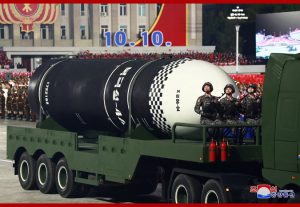North Korea Unveils Two New Strategic Missiles in October 10 Parade
As widely expected, North Korea unveiled new missile capabilities during its military parade on October 10, marking the 75th anniversary of the founding of the Korean Workers Party.[1] But the specific new missiles revealed were a surprise: a road-mobile, liquid-propellant intercontinental ballistic missile (ICBM) much larger than previously known North Korean systems and a new solid-propellant submarine-launched ballistic missile (SLBM).
This paper provides an initial assessment of each of the two missiles based on the limited information currently available. Parading these two systems around has an obvious political messaging component; however, operationally, the rationale for such a very large ICBM is unclear and the new SLBM would only add marginally at best to the already sizable regional threat from North Korea’s land-based missiles.
The New ICBM

The new ICBM, presumably a Hwasong-16, appears to be approximately 25-26 m long and 2.5-2.9 m in diameter—about 4-4.5 m longer and about 0.5 m larger in diameter than the North’s Hwasong-15 ICBM flight tested once in November 2017. Indeed, the new missile has been correctly characterized as the world’s largest mobile ICBM—in part because countries with ICBMs generally seek to make their road-mobile ICBMs smaller so they can be more mobile and concealable.
That said, we estimate the new missile’s launch weight at roughly 100,000-150,000 kg, compared to some 80,000 kg for the Chinese DF-41 solid-propellant, road-mobile ICBM and about 104,000 kg for the former Soviet SS-24 rail-mobile solid ICBM.

The first stage of the new ICBM appears large enough in diameter to accommodate four of the Soviet RD-250-sized rocket engines believed to power the Hwasong-15 (which uses two in its first stage). The number and type of engine used in its presumed second stage are unclear, making the new missile’s throw-weight capability uncertain. Based on the assumption of four RD-250-type engines in the first stage, however, we estimate the new missile could, in principle, deliver 2,000-3,500 kg of payload to any point in the continental United States—much greater than the Hwasong-15’s assessed 1,000 kg payload capability to the same range.
But why would the North Korean’s need or want such a big missile? Especially since the Hwasong-15 would appear to have sufficient range/payload capability and room for improvement to meet North Korea’s operational targeting needs, and is much easier to move and conceal. There are two main possibilities, which are not mutually exclusive.
First, there may be a political rationale for producing or parading the new system. An unexpected “super heavy” ICBM would be a classically Khrushchevian[2] statement of North Korea’s technical prowess, the robustness of its ability to threaten the US,[3] and the permanence of its nuclear weapons status. It is worth noting that there has been no open-source evidence that the new ICBM’s apparent first-stage propulsion system has been ground-tested, and one analyst has noted that “no North Korean ICBM design that was *first seen at a parade* has seen flight-testing to date.”
Second, there may be operational reasons to make such a large missile. The North may want to be able (or to be seen as able) to deliver a much larger payload to anywhere in the US.
In terms of larger payloads, the North may be working toward developing multiple independently-targetable reentry vehicles (MIRVs). Perhaps the North’s current nuclear RVs are larger and heavier than we expect, and so the Hwasong-15 cannot carry enough such RVs along with the size of post-boost vehicle (PBV) the North currently can provide to dispense them. Or perhaps the Hwasong-15 can be MIRVed but the North wants to be able to deliver more MIRVs per booster.
It should be noted that North Korea has not demonstrated a militarily useful MIRV capability, which is technically demanding. For example, it has yet to flight test a PBV, much less the deployment of MIRVs from a PBV. Given the technical demands of MIRVs, it might instead first deploy non-independently targetable Multiple Reentry Vehicles (MRVs) like the US, USSR, and UK did. Even in this case, the North might want more payload capability to deploy more or larger MRVs.
Another reason for having a bigger payload capacity is the desire to carry more and/or more RV-like (heavier) decoys to spoof US missile defenses than is possible with the Hwasong-15. Alternatively, the North may have decided that it wanted to possess or portray the capability to deliver a “super heavy” single large thermonuclear RV against US cities for political or deterrent effect. While this also is Khrushchevian in nature, one should recall that the Soviet SS-18, Chinese CSS-4 and US Titan-II ICBMs were deployed with massive single RVs having up to nine megatons of yield.[4]
Another size-related question raised by the new ICBM is: why make it road-mobile? Here, too, there could be a political component; after all, it is the world’s biggest mobile ICBM. But to the extent the North truly intends to deploy this system, it would almost certainly judge that road-mobile basing would be more survivable than silo- or other fixed-basing, even though the sheer size and weight of the new ICBM would render it less mobile than the Hwasong-15 and more constrained in the portions of the road network it could use, (limited to smooth, paved roadways), and probably needing to fuel the missile after it was erected at a launch site (adding to vulnerability and reducing response time).
The New SLBM

We have not been able to estimate the dimensions of the new “Pukguksong-4” SLBM from the currently available images; one analyst suggests it may be the same size as the current Pukguksong-3/KN-26. The missile’s short-and-wide appearance makes sense given the constraints of a submarine launch tube, especially for the size of submarine North Korea probably would be using.
At least portions of the missile’s motor case appear to be filament-wound, a technology the North Koreans previously have suggested they possess. If the entire motor case were so constructed, that would reduce the missile’s structure weight and allow greater range/payload capability.
The North Koreans presumably intend for the new SLBM to have greater range than the 1,900 km estimated for their most recently tested SLBM (albeit fired from a test barge, not a submarine), the Pukguksong-3/KN-26. If the new SLBM uses a larger solid-fuel motor than the Pukguksong-3, there is no open source evidence that motor has been ground tested. If the new SLBM is intended to be deployed, it may be intended for the new conventionally powered ballistic missile submarine that North Korea hinted at building in July 2019.[5]
The military significance of the new SLBM will turn on its range capability: The longer the range, the closer to North Korean military protection its launching submarine can remain and still hit regional targets. We presume the Pukguksong-4 will not have sufficient range to strike Guam, Hawaii or the US West Coast without a vulnerable transit.
In any case, as noted elsewhere, this missile could provide only a marginal addition to the threat posed by the North’s much larger, increasingly longer range and much more survivable land-based ballistic missile force.
- [1]
Simon Denyer and Min Joo Kim, “North Korea Parades Huge, New ICBM, But Kim Jong Un Stresses Deterrent Nature,” The Washington Post, October 10, 2020, https://www.washingtonpost.com/world/northkorea-military-parade-missile-icbm/2020/10/10/f6f13a74-0869-11eb-8719-0df159d14794_story.html.
- [2]
From the mid-1950s to early 1960s, Soviet leader Nikita Khrushchev tried to compensate for what he knew to be the USSR’s nuclear inferiority by staging bomber fly-bys with the same small number of aircraft fly over again and again to portray having a large bomber force, ordering the testing of a 50-megaton nuclear device that was not reflective of actual deployable weapons, etc.
- [3]
Simon Denyer and Min Joo Kim.
- [4]
See Missile Defense Project, “SS-18 ‘Satan,’” Missile Threat, Center for Strategic and International Studies, August 10, 2016, last modified June 15, 2018, https://missilethreat.csis.org/missile/ss-18; Missile Defense Project, “DF-5 (Dong Feng-5 / CSS-4),” Missile Threat, Center for Strategic and International Studies, August 12, 2016, last modified November 18, 2019, https://missilethreat.csis.org/missile/df-5-ab; and Missile Defense Project, “Titan II,” Missile Threat, Center for Strategic and International Studies, March 22, 2017, last modified June 15, 2018, https://missilethreat.csis.org/missile/titan-ii.
- [5]
“Supreme Leader Kim Jong Un Inspects Newly Built Submarine,” KCNA, July 23, 2019, https://kcnawatch.org/newstream/1563840929-678423140/supreme-leader-kim-jong-un-inspects-newly-built-submarine.
